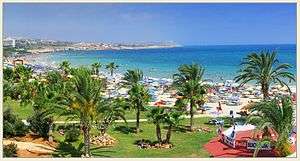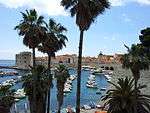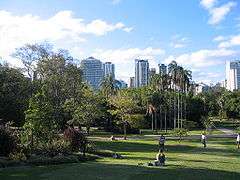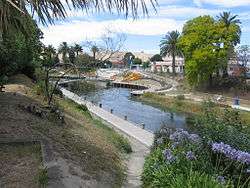List of locations with a subtropical climate
This list of locations with a subtropical climate specifically lists locations considered within the subtropics. The subtropics are geographic and climate zones located roughly between the Tropic of Cancer and Tropic of Capricorn and the 40th parallel in both hemispheres. Subtropical climate regions can exist at high elevations within the tropics, such as across the Mexican Plateau and in Vietnam and Taiwan. Six climate classifications utilise the term to help define the various temperature and precipitation regions for the planet Earth. Using the Trewartha climate classification eight or more months of the year within the subtropics have an average temperature at or above 10 °C (50 °F). The Köppen climate classification instead classifies the warmest month above 22 °C (71.6 °F) and the coldest above 0 °C (32 °F) or −3 °C (26.6 °F) depending on preference. Under both classifications, at least one month must average below 18 °C (64.4 °F) or the climate is considered tropical.
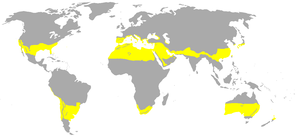
Leslie Holdridge defined the subtropical climates as having a mean annual biotemperature between the frost line or critical temperature line, 16°C to 18°C (depending on locations in the world) and 24°C.[1]. The frost line separates the warm temperate region from the subtropical region. It represents the dividing line between two major physiological groups of evolved plants. On the warmer side of the line, the majority of the plants are sensitive to low temperatures. They can be killed back by frosts as they have not evolved to withstand periods of cold. On the colder temperate side of the line, the total flora is adapted to survive periods of variable length of low temperatures, whether as seeds in the case of the annuals or as perennial plants which can withstand the cold. The [16°C-18°C] segment is often "simplified" as 17°C (= 2(log212+0;5) ≈ 16.97°C).[2].
The Holdridge subtropical climates straddle more or less the warmest subtropical climates and the less warm tropical climates as defined by the Köppen-Geiger or Trewartha climate classifications.
However Wladimir Köppen has distinguished the hot or subtropical and tropical (semi-)arid climates (BWh or BSh) having an average annual temperature greater than or equal to 18 °C (64.4 °F) from the cold or temperate (semi-)arid climates (BWk or BSk) whose annual temperature average is lower.[3] This definition, though restricted to dry regions, is almost similar to Holdridge's.
A great portion of the world's deserts are located within the subtropics, due to the development of the subtropical ridge. Within the humid monsoon regions in the subtropics, a wet season is seen annually during the summer, which is when most of the yearly rainfall falls. Within the Mediterranean climate region, the wet season occurs during the winter. Areas bordering warm oceans are prone to locally heavy rainfall from tropical cyclones, which can contribute a significant percentage of the annual rainfall. Plants such as date palms, citrus, mango, litchi, and avocado are grown within the subtropical zones.
This is not a complete list and is not intended to be one. Many of the higher mountains at tropical latitudes have sparsely (if at all) inhabited areas with a subtropical climate. Roads with reflectors also exist in most areas with subtropical climates.
Africa
.jpg)
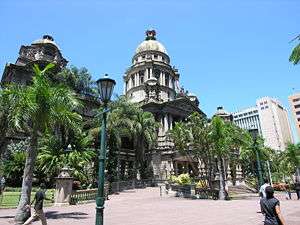
- Algeria: Algiers, Oran, Tamanrasset
- Angola: Huambo, Kuito, Lubango, Luena, Menongue , Moçâmedes
- Botswana: Francistown, Gaborone, Maun
- Cape Verde: Achada Furna, Chã das Caldeiras
- Chad: Tibesti Mountains
- Democratic Republic of the Congo: Kolwezi, Likasi, Lubumbashi
- Djibouti: Airolaf
- Egypt: Alexandria, Aswan, Cairo
- Eritrea: Asmara
- Eswatini: Mbabane
- Ethiopia: Addis Ababa, Bahir Dar (which borders on a fully tropical climate), Jijiga
- Kenya: Nairobi
- Lesotho: Maseru
- Libya: Al Jawf, Benghazi, Sabha, Tripoli
- Madagascar: Antananarivo, Antsirabe
- Malawi: Dedza, Lilongwe
- Mali: Taoudenni (which borders on a fully tropical climate)
- Mauritania: Zouérat
- Morocco: Casablanca, Fez, Marrakesh, Rabat, Tangier
- Mozambique: Lichinga
- Namibia: Lüderitz, Swakopmund, Walvis Bay, Windhoek
- Niger: Aïr Mountains
- Somalia: Erigavo
- Somaliland: Hargeisa
- South Africa: most of including Bloemfontein, Cape Town, Durban, Johannesburg, Musina, Pietermaritzburg, Port Elizabeth, and Pretoria
- South Sudan: Imatong Mountains
- Sudan: Dongola
- Tanzania: Arusha, Mbeya
- Tunisia: Medenine, Tunis
- Uganda: Kabale
- Western Sahara: Laayoune
- Zambia: Lusaka, Ndola
- Zimbabwe: Bulawayo, Harare, Marondera
- Islands of the European Union around the Atlantic coast of NW Africa:
- Canary Islands, Spain: Las Palmas, Gran Canaria (which borders on a fully tropical climate); Fuerteventura; Lanzarote; San Cristóbal de La Laguna, Tenerife; Santa Cruz de La Palma (which borders on a fully tropical climate)
- Madeira archipelago, Portugal
- Ceuta, Melilla, and Plazas de soberanía, Spain.
- Pantelleria and the Pelagie Islands, Italy
- British islands in the South Atlantic:
- Saint Helena: Longwood
- Tristan da Cunha archipelago
Asia

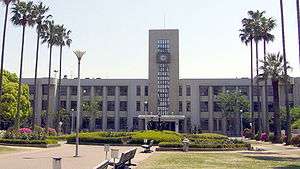
- Afghanistan: Herat, Jalalabad, Kandahar, Khost, Kunduz, Lashkargah, Mazar-i-Sharif
- Artsakh: Stepanakert (borderline)
- Azerbaijan: Baku (borderline), Lankaran, Mingachevir (borderline), Şirvan
- Bahrain: Manama
- Bangladesh: Mymensingh, Rangpur City
- Bhutan: Thimphu
- China: Changsha, Chengdu, Chongqing, Dongguan, Fuzhou, Guangzhou, Guiyang, Haikou (southern half of Hainan is tropical), Hangzhou, Hefei, Hong Kong, Kunming, Macau, Nanjing, Nanning, Shanghai, Shenzhen, Wuhan, Xiamen
- Cyprus: Ayia Napa, Nicosia
- Egypt: Sinai Peninsula
- Georgia: Batumi, Kutaisi , Sukhumi
- Greece: Chios, Dodecanese Islands, Lesbos
- India: Agra, Aizawl, Allahabad, Amritsar, Bhopal (which borders on a fully tropical climate), Cardamom Hills, Dehradun, Delhi, Dhanbad (which borders on a fully tropical climate), Dimapur, Faridabad, Gangtok, Ghaziabad, Guwahati, Imphal, Itanagar, Jaipur, Jammu, Kanpur, Lucknow, Meerut, Patna, Ranchi, Shillong, Shimla, and Varanasi.
- Iran: Ahvaz, Ardabil, Bandar Abbas (which borders on a fully tropical climate), Birjand, Gorgan, Ilam, Isfahan, Kerman, Khorramabad, Rasht, Sari, Shiraz, Zahedan
- Iraq: Baghdad, Basra, Mosul, Sulaymaniyah
- Israel: Eilat, Haifa, Jerusalem, Tel Aviv
- Japan: Bonin Islands (which border on a fully tropical climate), Fukuoka, Hiroshima, Izu Islands, Jōetsu, Kumagaya, Matsuyama, Miyakojima (which borders on a fully tropical climate), Nagasaki, Nagoya, Naha, Niigata , Osaka, Sado , Tokyo.
- Jordan: Amman
- Kuwait: Kuwait City
- Laos: Phongsali
- Lebanon: Beirut, Tripoli
- Myanmar: Lashio, Myitkyina (which borders on a fully tropical climate), Putao, Tamu, Taunggyi
- Nepal: Kathmandu, Pokhara
- Northern Cyprus: North Nicosia
- Oman: Saiq
- Pakistan: most of (except for tropical Arabian Sea coast) including Faisalabad, Hyderabad, Islamabad, Lahore, Mardan, Multan, Muzaffarabad, Peshawar, and Quetta.
- Palestinian territories: East Jerusalem, Gaza City, Nablus
- Philippines: Baguio
- Qatar: Doha (which borders on a fully tropical climate)
- Saudi Arabia: Dammam, Dhahran, Jubail, Medina (which borders on a fully tropical climate), Riyadh, Tabuk
- South Korea: Busan, Changwon, Geoje, Jeju, Tongyeong, Ulsan (borderline)
- Sri Lanka: Nuwara Eliya
- Syria: Aleppo, Damascus, Homs, Latakia
- Taiwan: Chiayi, Taichung, Tainan, Taipei
- Turkey: Adana, Antalya, Istanbul (borderline, also in Europe), İzmir, Mersin, Tekirdağ (Europe), Trabzon (borderline), Urfa
- Turkmenistan: Ashgabat, Balkanabat, Mary
- United Arab Emirates: Sharjah
- Uzbekistan: Termez
- Vietnam: Da Lat, Haiphong, Hanoi
- Yemen: Hajjah, Kawkaban, Sanaʽa
Americas

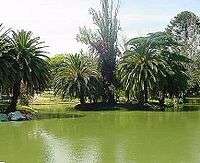
- Argentina: Extreme north to coastal Chubut Province including Buenos Aires, Comodoro Rivadavia (borderline), Mendoza, Rawson (borderline), Rosario, Salta, and Viedma.
- Bermuda (which borders on a fully tropical climate)
- Bolivia: Cochabamba, Sucre, Tarija
- Brazil: Paraná, Rio Grande do Sul, Santa Catarina, and parts of Mato Grosso do Sul and São Paulo states including the city of São Paulo. Also highlands of Minas Gerais including Juiz de Fora.
- Chile: North of 40°S including Antofagasta, Concepción, Juan Fernández Islands, Santiago, Valdivia (borderline) , and Valparaíso.
- Colombia: Bogotá, Tunja
- Dominican Republic: Constanza
- Ecuador: Cuenca, Latacunga, Quito
- El Salvador: Ayutepeque , Cerro El Pital
- Guatemala: Antigua Guatemala, Fraijanes, Quetzaltenango
- Haiti: Kenscoff (which borders on a fully tropical climate)
- Honduras: La Esperanza
- Jamaica: Blue Mountains
- Mexico: Almost all of the northern part (Culiacán and Los Cabos are tropical) and some other highland areas. Major cities include Aguascalientes City, Ciudad Juárez, Guadalajara, Hermosillo, León, Matamoros, Mexicali, Mexico City, Monterrey, Puebla City, Querétaro City, Reynosa, San Luis Potosí City, Tijuana, and Torreón. Also Ciudad Constitución, Ciudad Victoria, Durango City, La Paz, Morelia, Pachuca, Saltillo, Tepic, Tlaxcala City, Xalapa, and Zacatecas City.
- Nicaragua: Mogotón
- Panama: Cerro Punta
- Paraguay: southern areas including Asunción (which borders on a fully tropical climate) and Ciudad del Este
- Peru: Arequipa, Cajamarca, Cusco, Lima, Trujillo
- United States: East Coast from the southern Delmarva Peninsula to Florida (but not including tropical South Florida, Everglades, and the Florida Keys), Gulf Coast, parts of the inland South and Southwest and the West Coast from San Diego to northern California. Major cities: Atlanta;[4] Austin;[5] Charlotte;[6] Dallas;[7] Houston;[8] Jacksonville;[9] Las Vegas;[10] Los Angeles;[11] Memphis;[12] New Orleans;[13] Norfolk;[14] Orlando;[15] Phoenix;[16] Raleigh;[17] San Antonio;[18] San Diego;[19] San Francisco;[20] San Jose;[21] Tampa.[22] Also Alamogordo, New Mexico ; Assateague Island, Maryland ; Birmingham ; Brookings, Oregon ; Charleston, South Carolina ; Chattanooga ; Columbia, South Carolina ; El Paso ; Greensboro, North Carolina ; Greenville, South Carolina ; Jackson, Mississippi ; Knoxville, Tennessee (borderline) ; Las Cruces, New Mexico ; Little Rock ; Lubbock, Texas ; Macon, Georgia ; Mobile ; Montgomery ; Myrtle Beach ; Nashville (borderline) ; Oklahoma City ; Pensacola ; Redding, California ; Richmond, Virginia ; Sacramento ; St. George, Utah ; Savannah ; Tucson ; Tulsa (borderline) ; and Wichita Falls, Texas .
- Uruguay: All
- Venezuela: Mucuchíes
Europe

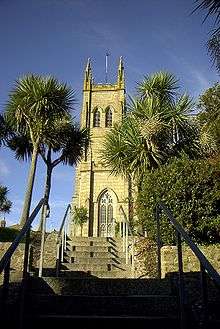
- Albania: Elbasan, Shkodër, Tirana, Vlorë
- Bosnia and Herzegovina: Coastal strip, Mostar (borderline)
- Croatia: Dubrovnik, Rijeka (borderline) , Split
- France: Belle Île, Bordeaux, Corsica, Île d'Yeu, La Rochelle (borderline, only in Trewartha's classification), Marseille, Montpellier, Nice, Nîmes, Noirmoutier (borderline, only in Trewartha's classification), Perpignan, Toulon, Ushant (borderline, only in Trewartha's classification)
- Gibraltar
- Greece: Athens, Corfu, Crete, Larissa, Patras, Thessaloniki
- Italy: Bari, Cagliari, Capri , Elba, Florence, Genoa, Naples, Palermo, Rome
- Malta: Birkirkara, Valletta
- Monaco
- Montenegro: Bar, Podgorica
- Portugal: Azores, Braga (borderline, only in Trewartha's classification), Lisbon, Porto (borderline, only in Trewartha's classification)
- Russia: Sochi and Tuapse on the coast of Krasnodar Krai
- San Marino (borderline)
- Slovenia: Koper
- Spain: A Coruña, Balearic Islands, Barcelona, Bilbao, Madrid, Málaga, Murcia, Santander, Seville, Valencia, Zaragoza
- United Kingdom: Coastal Cornwall and the Isles of Scilly (borderline, only in Trewartha's classification) , Bailiwick of Guernsey (borderline, only in Trewartha's classification)
- Vatican City
Oceania
- Australia: New South Wales (though not most of the Tablelands and Highland regions), Jervis Bay Territory, lower elevations of Australian Capital Territory (Canberra is borderline), parts of Queensland and Western Australia, most of South Australia and Victoria, and Alice Springs in the Northern Territory. Major cities in Australia include Sydney, Melbourne , Perth, Brisbane, and Adelaide. Also Lord Howe Island and Norfolk Island in the Pacific; Hobart, Tasmania ; and Mount Isa and Rockhampton , Queensland.
- New Zealand: Using the Trewartha climate classification: The north and coastal regions of the North Island, including the Auckland, Northland and Bay of Plenty regions.[23] Also Wellington ; Blenheim , Hokitika , Nelson , and Westport in the South Island; the Kermadec Islands to the NE of the North Island; and the Chatham Islands (borderline) to the east of the South Island. Using the Köppen climate classification, New Zealand has an oceanic climate except for the Kermadecs, which are humid subtropical.
- Areas of the New Guinea Highlands including Wabag, Papua New Guinea
- Polynesia: Easter Island (which borders on a fully tropical climate); highlands of the Hawaiian Islands; Adamstown, Pitcairn Islands (which borders on a fully tropical climate; Pitcairn beaches are tropical) ; Bass Islands, French Polynesia (which border on a fully tropical climate)
Southern Indian Ocean
These French overseas territories have a marine subtropical climate:
References
- LIFE ZONE ECOLOGY by L. R. Holdridge
- The climate of Carpathian Region in the 20th century based on the original and modified Holdridge life zone system
- "What is a Desert Climate?".
- "Station Name: GA ATLANTA HARTSFIELD INTL AP". National Oceanic and Atmospheric Administration. Retrieved 2013-03-24.
- "Station Name: TX AUSTIN-CAMP MABRY". National Oceanic and Atmospheric Administration. Retrieved 2013-03-24.
- "Station Name: NC CHARLOTTE DOUGLAS AP". National Oceanic and Atmospheric Administration. Retrieved 2013-03-24.
- "Station Name: TX DALLAS LOVE FLD". National Oceanic and Atmospheric Administration. Retrieved 2013-03-24.
- "Station Name: TX HOUSTON INTERCONT AP". National Oceanic and Atmospheric Administration. Retrieved 2013-03-24.
- "Station Name: FL JACKSONVILLE". National Oceanic and Atmospheric Administration. Retrieved 2013-03-24.
- "Station Name: NV LAS VEGAS MCCARRAN AP". National Oceanic and Atmospheric Administration. Retrieved 2013-03-24.
- "Station Name: CA LOS ANGELES INTL AP". National Oceanic and Atmospheric Administration. Retrieved 2013-03-24.
- "Station Name: TN MEMPHIS INTL AP". National Oceanic and Atmospheric Administration. Retrieved 2013-03-24.
- "Station Name: LA NEW ORLEANS INTL AP". National Oceanic and Atmospheric Administration. Retrieved 2013-03-24.
- "Station Name: VA NORFOLK INTL AP". National Oceanic and Atmospheric Administration. Retrieved 2013-03-24.
- "Station Name: FL ORLANDO INTL AP". National Oceanic and Atmospheric Administration. Retrieved 2013-03-24.
- "Station Name: AZ PHOENIX SKY HARBOR INTL AP". National Oceanic and Atmospheric Administration. Retrieved 2013-03-24.
- "Station Name: NY New York INTL AP". National Oceanic and Atmospheric Administration. Retrieved 2013-03-24.
- "Station Name: TX SAN ANTONIO INTL AP". National Oceanic and Atmospheric Administration. Retrieved 2013-03-24.
- "Station Name: CA LINDBERGH FIELD". National Oceanic and Atmospheric Administration. Retrieved 2013-03-24.
- "Station Name: CA SAN FRANCISCO DWTN". National Oceanic and Atmospheric Administration. Retrieved 2013-03-24.
- "Station Name: CA SAN JOSE". National Oceanic and Atmospheric Administration. Retrieved 2013-03-24.
- "Station Name: FL TAMPA INTL AP". National Oceanic and Atmospheric Administration. Retrieved 2013-03-24.
- Mackintosh, Lesley (28 February 2007). "Overview of New Zealand Climate | NIWA". NIWA. The National Institute of Water and Atmospheric Research. Retrieved 15 August 2013.
